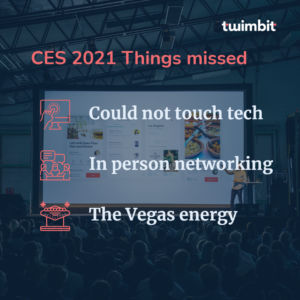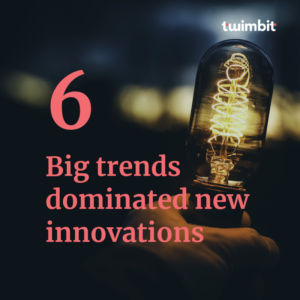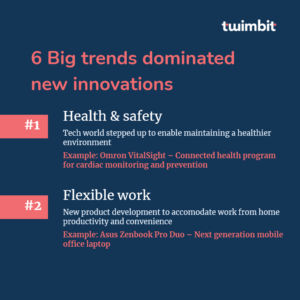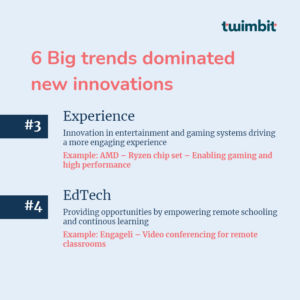This year’s CES was different – and kudos to Gary Shapiro and the team at the Consumer Technology Association for pulling off a 100% virtual event.
Gone were many things that I did not miss – crowding with 100,000 + manic people every waking minute, standing on long lines for shuttles events and meals, not seeing many of the sessions and people I really wanted to meet, spending hours in transit from venue to venue. Of course, there were things I did miss – being able to touch the technology, meeting new unexpected people, Vegas, and feeling the energy in the room when something truly revolutionary was revealed.
With all those pros and cons, CES delivered a great event, and proved to be a great case study how an organization can set an ambitious, large scale goal in the midst of the pandemic and achieve it. That by itself, should inspire many companies to bravely confront and persevere through this crisis. CES had keynotes, panels, technology showcases, demos, entertainment, and networking – much delivered in cool, video packages – and the ability to watch on demand sessions so you can be assured of seeing what you want to see.
As in prior years, CES had the usually “next generation” products with the latest features making tech faster, more powerful, easier, cooler, lighter. Unlike prior years, with the pandemic and social issues being in the headlines, CES content was very focused on issues and products to help consumers and business deal with the new normal. Most notable product developments were by GM- new EV’s and a goal to become 100% electric, Verizon – 5G network, LG – rollable TV’s, AMD – Ryzen next generation computer chips.
Six big trends that have driven new innovations this past year are highlighted below. And these trends are not short term. Given the quality of life and benefits they deliver, it is expected these trends will outlive the pandemic and drive even more innovation in the years to come.
1. Health and Safety
In the midst of the pandemic, the tech world has stepped up and innovated so many devices and applications that enable maintaining a healthier environment at home and using biosensors to proactively monitoring your health, and effectively diagnosing and treating with remote telehealth platforms.
2. Flexible Work
With work from home becoming a necessity there were many products aimed at enabling productivity and convenience at home – from video conferencing, to more powerful PCs, headsets and speakers. The consensus is we will never fully go back the office and will settle into some hybrid model where home-work time will replace most in-office time. So, consumers are seeking to make the home more livable and tech friendly. The industry has responded with many innovative Smart Home products spanning electronics, appliances, bed and bath, sanitation, and utilities.
3. Experience
Since many conventional forms of entertainment are no longer accessible to the consumer, they seek in-home products as new sources of amusement. New developments in home entertainment systems and gaming are huge with the underlying tech (chips, VR/AR, AI) driving a more engaging experience.
4. EdTech
Bridging the digital divide was a big topic with the opportunity and the need to introduce tech to underprivileged at an early age, and to provide tech skills development to people via non-traditional pathways instead of a four-year college degree. New platforms and applications are empowering remote and continuous learning along with new uses of VR / AR. This all translates to more job opportunities, be it direct tech jobs, field work enabling tech infrastructure, or transformed positions using tech to improve traditionally low-tech jobs.
5. 5G
5G will be the new electricity of the 21st century powering an entirely new wave of smart apps and experiences promising speeds of 100 times faster than 4G. Consumers and businesses who have access to 5G will attain far higher levels of quality of life and productivity. 5G ubiquity is a necessary goal to eliminate the digital divide. 5G is a key factor driving the viability of many innovations and will require collaboration of large networking companies, app developers and government agencies to prioritize the needed infrastructure investments.
6. Sustainability
With all of the above, sustainability goals are more achievable than ever. Smart energy and water platforms, zero emissions cars, “connected everything” all lead to proactive monitoring and preventive outcomes, improving society by reducing waste, accidents, and illness.
Conclusion
In conclusion, synthesizing the entire CES experience, the overriding theme of Social Responsibility stood out. Microsoft President, Brad Smith’s keynote highlighted how technology plays a major role (especially in times of adversity, like now) to advance society and improve the quality of life. He cited JFK’s memorable moon launch speech stating:
“Technology has no conscience of its own… whether it will become a force for good or ill, depends on man”
– John F. Kennedy, 35th U.S. President
Tech companies must seize the moment and continue to drive innovation with a focus on social responsibility, demonstrate empathy, overcome privacy and trust issues, create productive public / private partnerships with government, and eliminate the digital divide and inequity gaps.
CES went beyond showing us lots of gadgets, it gave us lots to think about the potential of tech, our responsibility to channel it, and to be inspired by it, as we strive to make 2021 a breakout year.












